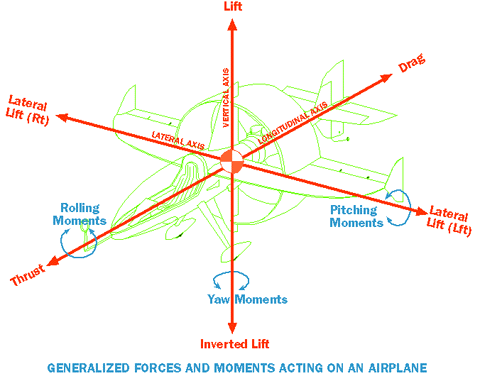
What is Maneuverability?
One would assume that a concept such as “maneuverability” would be strictly defined and commonly understood. Nonetheless, the term is generally applied as a vague subjective measure of an aircraft’s ability to move freely around the sky.
Hummingbird approaches maneuverability with rigor. To demonstrate this fact we will begin by offering a definition, in physical terms, of what maneuverability actually is. Then we will proceed to show why Hummingbird will be the most maneuverable aircraft ever built.
To clarify our terminology, let us begin by looking at the generalized forces and moments acting on the three axes of an airplane in flight.

In the most generalized terms, we define an aircraft’s maneuverability as follows:
An aircraft’s maneuverability is determined by its ability to:
- Change ATTITUDE around the aircraft’s three axes (longitudinal, lateral, and vertical).
- Change VELOCITY on the aircraft’s three axes, and in the three spatial dimensions (1 vertical and 2 horizontal).
Following on from our definition:
- Changes in ATTITUDE on each axis are created by the MOMENTS acting on the aircraft on that axis and are resisted by the MASS MOMENTS OF INERTIA of the aircraft on that axis.
- Changes in VELOCITY on each axis are created by the FORCES acting on that axis and are resisted by the MASS INERTIA (mass, or weight) of the aircraft.
Thus, to increase maneuverability, we lower the INERTIAS of the aircraft and increase the available MOMENTS and FORCES. Let us look at each of these in turn:
Inertias
To minimize an aircraft’s INERTIAS, one minimizes the mass (weight) of the aircraft and concentrates that mass as close as possible to the center of gravity (CG).
- Hummingbird’s weight is less than that of existing aircraft of similar power through the use of high power-to-weight ratio engines, advanced composite structures, and a self-bracing structural configuration.
- Hummingbird’s mass moments of inertia are reduced by placing the engines and propellers near the CG.
Moments
To maximize CONTROL MOMENTS, one maximizes the area and efficiency of the control surfaces and the velocity of the airflow passing over them.
- At normal flight speeds, Hummingbird’s control moments on all three axes are similar to those of existing aerobatic aircraft.
- At low and zero airspeeds, Hummingbird’s control moments will surpass those of other aircraft due to the fact that the tail surfaces and statorons are immersed in the accelerated airflow from the propulsion system.
Forces
LONGITUDINAL FORCES are determined by the available thrust and drag.VERTICAL FORCES are determined by the available lift (upright and inverted).
LATERAL FORCES are determined by the available lateral lift.
[Note that the vertical and lateral lifting forces acting on an airplane are coupled to the airplane’s airspeed and attitude relative to the free airstream (called angle of attack). Longitudinal forces (thrust and drag) are coupled to airspeed.]
- Hummingbird’s available thrust, at sea level, will approach 150% of its weight. This will allow vertical climbs up to hover ceiling (in excess of 5000 ft altitude).
- Hummingbird’s available drag will approach 100% of its weight at approximately 200 mph. This will allow vertical dives without exceeding flutter speeds.
- Hummingbird’s upright and inverted lifting power (relative to weight) and L/D will exceed those of existing configurations due to the low wing loading, high span efficiency, and high maximum lift coefficients.
- Hummingbird’s lateral lifting power and L/D will far exceed those of any existing aircraft, due to the large vertical surface area and high vertical span efficiency. This will allow efficient side-flight for the first time.
- High vertical and lateral lifting forces will remain available down to zero or even negative airspeeds due to the unique and powerful aerodynamic coupling of Hummingbird’s lifting and propulsion systems.
What about the Super-Fighters?
The preceding discussion clearly disposes of any existing aerobatic aircraft. But what about modern high-maneuverability fighters? While very agile and able to fly at extreme angles of attack, these aircraft are still heavily optimized for speed, and therefore cannot compete with Hummingbird under the pure definition of maneuverability offered above. In particular:
- They have very limited lateral lift capacity and therefore cannot fly efficiently on their sides.
- They cannot create sufficient drag to sustain a vertical dive.
- At low airspeeds, their high wing loadings and low L/D (low span and span-efficiency) renders them relatively unmaneuverable, even with such exotic features as active controls and vectored thrust.
- At high airspeeds they can demonstrate very high manuevering rates (rapid changes in attitude), but they can change pitch attitude and direction only within severely limiting stress boundaries (or they will tear themselves apart).
- While the modern experimental jets do employ thrust vectoring to control post-stall, high angle of attack flight, their configuration does not facilitate the aerodynamic coupling of propulsion and lifting systems.
Hummingbird will never be able to catch a jet fighter in a drag race (except for the first few seconds off the starting line). But it will tie any aircraft in knots if challenged to a test of pure agility.
Conclusion
I conclude my argument that Hummingbird will be the most maneuverable piloted aircraft ever built by human hands. [Unless, of course, the Atlanteans really did build Vimanas (“Flying Ships,” UFO’s).]11 October 1998



© Copyright 1992-2009 Philip Carter